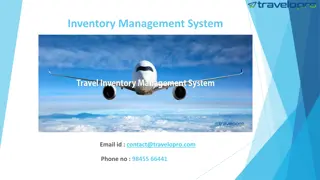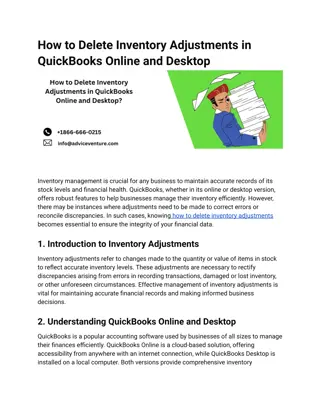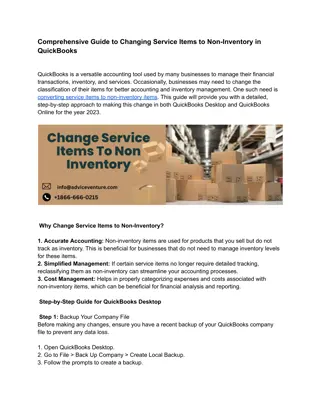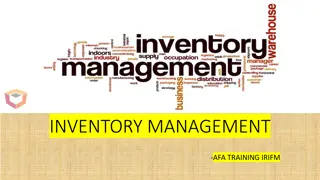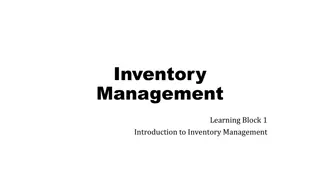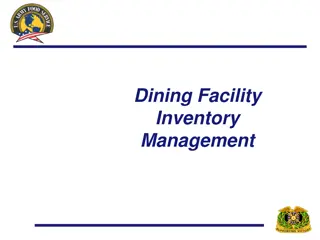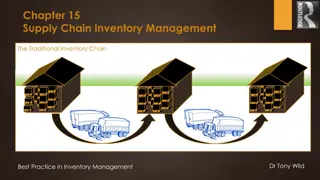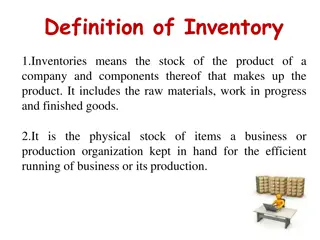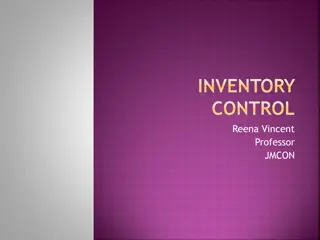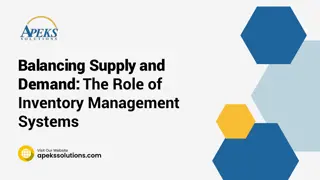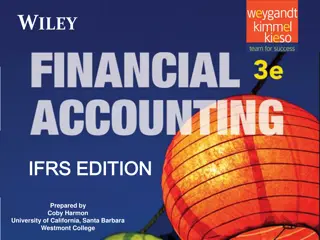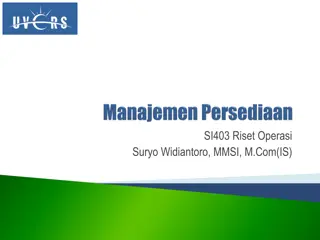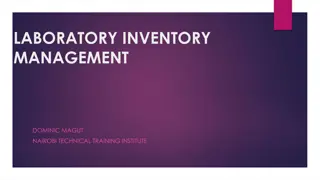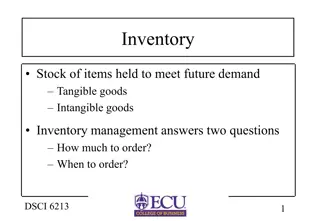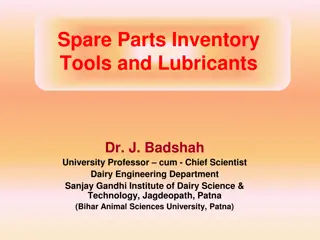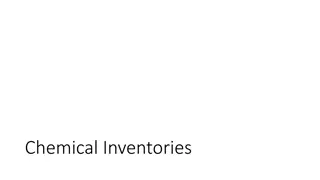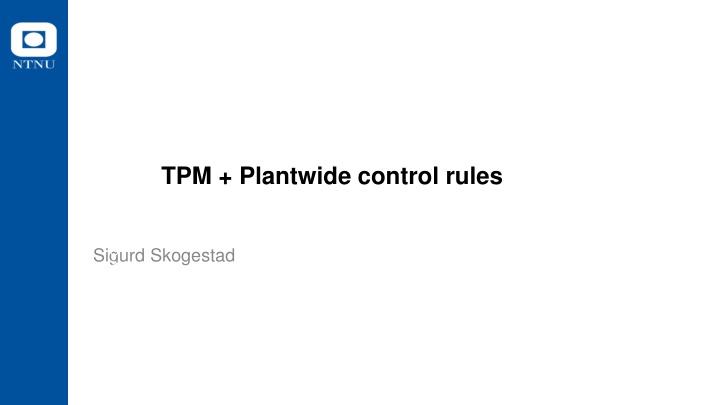
Control Structure Design Procedure for Process Plants
"Learn about the Skogestad procedure for optimizing control structures in process plants, including steps for operational objectives, degrees of freedom, inventory control decisions, and more."
Uploaded on | 1 Views
Download Presentation

Please find below an Image/Link to download the presentation.
The content on the website is provided AS IS for your information and personal use only. It may not be sold, licensed, or shared on other websites without obtaining consent from the author. If you encounter any issues during the download, it is possible that the publisher has removed the file from their server.
You are allowed to download the files provided on this website for personal or commercial use, subject to the condition that they are used lawfully. All files are the property of their respective owners.
The content on the website is provided AS IS for your information and personal use only. It may not be sold, licensed, or shared on other websites without obtaining consent from the author.
E N D
Presentation Transcript
Norwegian University of Science and Technology TPM + Plantwide control rules Sigurd Skogestad
Outline Skogestad procedure for control structure design: I. Top Down Step S1: Define operational objective (cost) and constraints Step S2: Identify degrees of freedom and optimize operation for disturbances Step S3: Implementation of optimal operation What to control? (primary CV s) (self-optimizing control) Step S4: Where set the production rate? (Inventory control) Bottom Up Step S5: Regulatory control: What more to control (secondary CV s)? Step S6: Supervisory control Step S7: Real-time optimization II. 2
Step S4. Where set production rate? Throughput manipulator (TPM) = MV for controlling throughput (production rate, network flow) Where set the production rate = Where locate the TPM? Traditionally: At the feed For maximum production (with small backoff): at the bottleneck Very important decision that determines the structure of the rest of the inventory control system! May also have important economic implications Link between Top-down (economics) and Bottom-up (stabilization) parts Inventory control is the most important part of stabilizing control 3
Production rate set at inlet: Inventory control in direction of flow* TPM * Required to get local-consistent inventory control 4
Production rate set at outlet: Inventory control opposite flow* TPM * Required to get local-consistent inventory control 5
Production rate set inside process* TPM * Required to get local-consistent inventory control 6
General: Need radiating inventory control around TPM (Georgakis) 7
Consistency of inventory control Consistency (required property): An inventory control system is said to be consistent if the steady-state mass balances (total, components and phases) are satisfied for any part of the process, including the individual units and the overall plant. 8
Local-consistency rule Rule 1. Local-consistency requires that 1. The total inventory (mass) of any part of the process must be locally regulated by its in- or outflows, which implies that at least one flow in or out of any part of the process must depend on the inventory inside that part of the process. 2. For systems with several components, the inventory of each component of any part of the process must be locally regulated by its in- or outflows or by chemical reaction. 3. For systems with several phases, the inventory of each phase of any part of the process must be locally regulated by its in- or outflows or by phase transition. Proof: Mass balances Note: Without the word local one gets the more general consistency rule 9
QUIZ 1 Consistent? p1 p2 z Controlling pressure at outlet is possible, but not consistent! (m is uncontrolled) 10
Flow split: May give extra DOF Split: Extra DOF (FC) Flash: No extra DOF TPM TPM 11
Closed system: Must leave one inventory uncontrolled Control smallest inventory! (b) is best if m1is large 12
Example: Separator control (oil-gas separation offshore) 13
Example: Separator control Alternative TPM locations Compressor could be replaced by valve if p1>pG 14
Alt.2 Alt.1 Alt.4 Alt.3 Similar to original but NOT CONSISTENT (two TPMs) 15
Location of sensors Location flow sensor (before or after valve or pump): Does not matter from consistency point of view Locate to get best flow measurement Before pump: Beware of cavitation After pump: Beware of noisy measurement Location of pressure sensor (before or after valve, pump or compressor): important from consistency point of view 16
General consistency rule Inventory loop must not cross TPM Rule applies also to case with long loops , which is when we don t try have local consistency. 17
PC FC PC FC FC PC FC PC PC FC 18 For each of the five structures; Where is the TPM? Is it consistent?
Solution according to radiation rule PC FC TPM NO PC FC YES TPM FC PC NO TPM FC PC YES (it does not matter where the flow is measured; the valve determines the location of the TPM) TPM PC FC YES TPM Note: Can never control pressure at ends (upstream first control valve or downstream last valve)! 19
PC FC PC FC PC FC FC PC FT PT Same sensor location as case 3. Can you control both flow and pressure using valves 1 and 2, Valves 2 and 3? 3 1 2 Some more. For each of the five structures; Where is the TPM? Is it feasible? 20
PC FC TPM NO PC NO. Rule: Another loop cannot cross the TPM, FC TPM PC FC NO, cannot cross TPM TPM FC PC NO TPM FC PC YES. More possibilities, 4 possible, 2 impossible TPM Some more. For each of the five structures; Where is the TPM? Is it feasible? 21
Where should we place the TPM? (Dynamics!) TPM = MV used to control throughput Traditionally: TPM = Main feed valve (or pump/compressor) Gives inventory control in direction of flow Consider moving TPM if: 1. There is an important CV that could otherwise not be well controlled Special case: Max. production is important: Locate TPM at process bottleneck* ! TPM can then be used to achieve tight bottleneck control (= achieve max. production) Economics: Max. production is very favorable in sellers marked 2. If placing it at the feed may yield infeasible operation ( overfeeding ) If snowballing is a problem (accumulation in recycle loop), then consider placing TPM inside recycle loop BUT: Avoid a variable that may (optimally) saturate as TPM (unless it is at bottleneck) Reason: To keep controlling CV=throughput, we would need to reconfigure (move TPM)** *Bottleneck: Last constraint to become active as we increase throughput -> TPM must be used for bottleneck control **Input saturation pairing rule (to reduce need for reassigning loops): Pair MV that may (optimally) saturate with CV that may be given up 22
Often optimal: Locate TPM at bottleneck! "A bottleneck is a unit where we reach a constraint which makes further increase in throughput infeasible" If feed is cheap and available: locate TPM at bottleneck (dynamic reasons) If the flow for some time is not at its maximum through the bottleneck, then this loss can never be recovered. 23
Example: two distillation columns in series 4 steady-state DOFs TPM 24
Active constraint regions for two distillation columns in series Energy price [$/mol] xA, xB, xC, V1 and V2 0 1 [mol/s] operate at BOTTLENECK Higher F infeasible because all 5 constraints reached 25
Control of distillation columns Energy price = 0.02$/mol (low) PC PC LC LC Overpurified CC xB,s = 95% TPM Self-optimizing: xA,opt = 2% CC F = 1.45 mol/s MAX MAX LC LC Overpurified Overpurified: To avoid loss of valuable product B 26
Increase feedrate: reach xAconstraint PC PC LC LC CC CC xB,s = 95% xA,s = 95% TPM F = 1.48 mol/s MAX MAX LC LC Overpurified Implement: Use Max-selector for L1 27
Increase feedrate further: reach also xCconstraint infeasible PC PC LC LC CC CC xB,s = 95% xA,s = 95% TPM F = 1.50 mol/s MAX MAX LC LC xC UNCONTROLLED! Will drop below 95% C if F gets too large 28
Feasible operation with 5 constraints (process bottleneck): TPM as MV PC PC LC LC CC CC xB,s = 95% xA,s = 95% TPM MAX MAX LC LC CC long loop xC,s = 95% Implement: Use Min-selector for F Possible solution to avoid long loop: Move TPM to B1 =feed column 2 (and change LC in column 1) Comment: This may be undesirable because there is a delay from feed to bottom level (typically 1 min) 29
Can we find a simple structure (with selectors) that works in all regions? I don t think so Energy price [$/mol] xA, xB, xC, V1 and V2 0 1 [mol/s] operate at BOTTLENECK Higher F infeasible because all 5 constraints reached 30 Need to find self-optimizing variables for remaining unconstrained DOFs in all regions
Long loop Loop that depends on other loops being closed to work Typical case: pair variables with process gain = 0 (open loop) 31
Single-loop alternatives for bottleneck control Bottleneck. Want max flow here Traditional: Manual control of feed rate TPM Alt.1. Feedrate controls bottleneck flow ( long loop ): Fmax FC TPM Alt. 2: Feedrate controls lost task (another long loop ): Fmax TPM Alt. 3: Reconfigure all upstream inventory loops: Alt. 3 can be done automatically! Will come back to this later! Fmax 32 TPM
EXAMPLE: Recycle plant (Luyben, Yu, etc.) Recycle of unreacted A (+ some B) 5 Feed of A 4 1 2 Given feedrate F0and column pressure: 3 Product (98.5% B) Dynamic DOFs: Column levels: Steady-state DOFs: Nm= 5 N0y= 2 N0= 5 - 2 = 3 33
Recycle plant: Optimal operation 1 remaining unconstrained degree of freedom 34
Control of recycle plant Active constraint Mr = Mrmax Self-optimizing L/F constant: Easier than two-point control Assumption: Minimize energy (V) Active constraint xB = xBmin 35
Modified Luybens law to avoid snowballing Luyben law no. 1 ( Plantwide process control , 1998, pp. 57): A stream somewhere in all recycle loops must be flow controlled Luyben rule is OK dynamically (short time scale) BUT economically (steady-state): Recycle should increase with throughput Modified Luyben s law 1 (by Sigurd): Consider moving the TPM inside the recycle loop 36
NOTE: There are actually two recycles! One through the reactor (D or F) One through the column (L) One flow inside both recycle loops: V Alternative: TPM=V if we want to break both recycle loops! PC TC 37
Changing TPM to V PC LC Simulations (to be done) confirm This is the best! LC L XC L and F for composition control: OK! F TC TPM XC LC 38
What about keeping V constant? (in addition to having another TPM) PC LC TPM L NO! Never control cost J=V LC F0 F TC V XC LC 39
Conclusion TPM (production rate manipulator) Think carefully about where to place it! Difficult to undo after design 40
Summary: Rules for plantwide control Here we present a set of simple rules for economic plantwide control to facilitate a close-to-optimal control structure design in cases where the optimization of the plant model is not possible. The rules may be conflicting in some cases and in such cases, human reasoning is strongly advised. 41 https://folk.ntnu.no/skoge/publications/2015/minasidis-pse-escape-2015/
Rule 1: Control the active constraints. In general, process optimization is required to determine the active constraints, but in many cases these can be identified based on a good process knowledge and engineering insight. Here is one useful rule: Rule 1A: The purity constraint of the valuable product is always active and should be controlled. This follows, because we want to maximize the amount of valuable product and avoid product give away (Jacobsen and Skogestad, 2011). Thus, we should always control the purity of the valuable product at its specification. For cheap products we may want to overpurify (purity constraint may not be active) because this may reduce the loss of a more valuable component. In other cases, we must rely on our process knowledge and engineering insight. For reactors with simple kinetics, we usually find that, the reaction and conversion rates are maximized by operating at maximum temperature and maximum volume (liquid phase reactor). For gas phase reactor, high pressure may increase the reaction rate, but this must be balanced against the compression costs. 43 Rules for Step S3: Selection of primary (economic) controlled variables, CV1
Rule 2: Control self-optimizing variables (for remaining unconstrained DOFs). This choice is usually not obvious, as there may be several alternatives, so this rule is in itself not very helpful. The ideal self-optimizing variable, at least, if it can be measured accurately, is the gradient of the cost function. Ju, which should be zero for any disturbance. Unfortunately, it is rarely possible to measure this variable directly and the self-optimizing variable may be viewed as an estimate of the gradient Ju The two main properties of a good self-optimizing (CV1=c=Hy) variable are: 1. Its optimal value is insensitive to disturbances (such that the optimal sensitivity dcopt/dd =Fc = HF = is small) 2. It is sensitive to the plant inputs (so the process gain dc/du = G = HGyis large). The following rule shows how to combine the two desired properties: Rule 2A: Select the set CV1=c such that the ratio G-1Fcis minimized. This rule is often called the maximum scaled gain rule . 44
Rule 3: Never try to control the cost J (or any other variable that reaches a maximum or minimum at the optimum) J J>Jmin Jmin J<Jmin ? u First, the cost function J has no sensitivity to the plant inputs at the optimal point and so G = 0 which violates Rule 2A. Second, if we specify J lower than its optimal value, then clearly, the operation will be infeasible Also, specifying J higher than its optimal value is problematic, as we have multiplicity of solutions. As mentioned above, rather controlling the cost J, we should control its gradient, Ju. 45
Rule 4: Locate the TPM close to the process bottleneck The justification for this rule is to take advantage of the large economic benefits of maximizing production in times when product prices are high relative to feed and energy costs (Mode 2). To maximize the production rate, one needs to achieve tight control of the active constraints, in particular, of the bottleneck, which is defined as the last constraint to become active when increasing the throughput rate (Jagtap et al., 2013). 46 Rules for Step S4: Location of throughput manipulator (TPM)
Rule 5: Locate the TPM inside the recycle loop, if there is one. The point is to avoid overfeeding the recycle loop which may easily occur if we operate close to the throughput where snowballing in the recycle loop occurs. This is a restatement of Luyben s rule Fix a Flow in Every Recycle Loop (Luyben et al., 1997). From this perspective, snowballing can be thought of as the dynamic consequence of operating close to a bottleneck which is within a recycle system. In many cases, the process bottleneck is located inside the recycle loop and Rules 4 and 5 give the same result. 47
Rule 6: Arrange the inventory control loops around the TPM location according to the radiation rule. The radiation rule (Price et al., 1994), says that the inventory loops upstream of the TPM location must be arranged opposite of flow direction. For flow downstream of TPM location it must be arranged in the same direction. This ensures local consistency , i.e., all inventories are controlled by their local in or outflows. 48 Rules for Step S5: Structure of regulatory control layer.
Rule 7: Select sensitive/drifting variables as controlled variables CV 2 for regulatory control This will generally include inventories (levels and pressures), plus certain other drifting (integrating) variables, for example, a reactor temperature or a sensitive temperature in a distillation column. This ensures stable operation, as seen from an operator s point of view. Some component inventories may also need to be controlled, especially for recycle systems. For example, according to Down s drill one must make sure that all component inventories are self- regulated by flows out of the system or by removal by reactions, otherwise their composition may need to be controlled (Luyben, 1999). 49
Rule 8: Economically important active constraints should be selected as controlled variables CV 2 in the regulatory layer Economic variables CV 1 are generally controlled in the supervisory layer. Moving them to the faster regulatory layer may ensure tighter control with a smaller backoff. The backoff is the difference between the actual average value (setpoint) and the optimal value (constraint). 50



